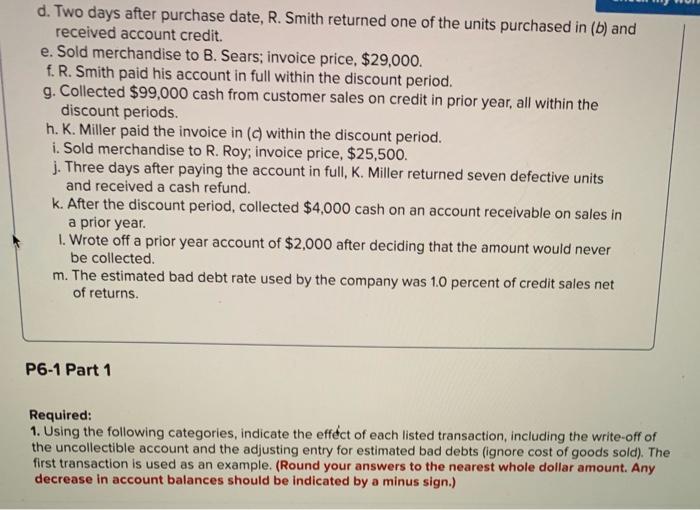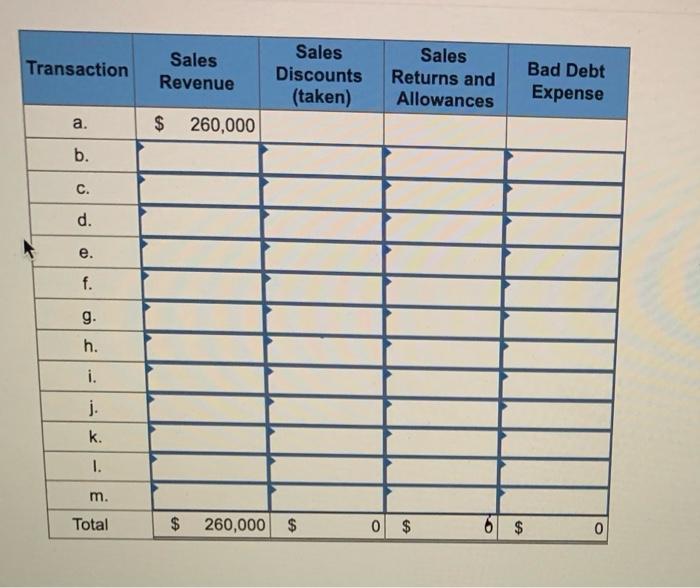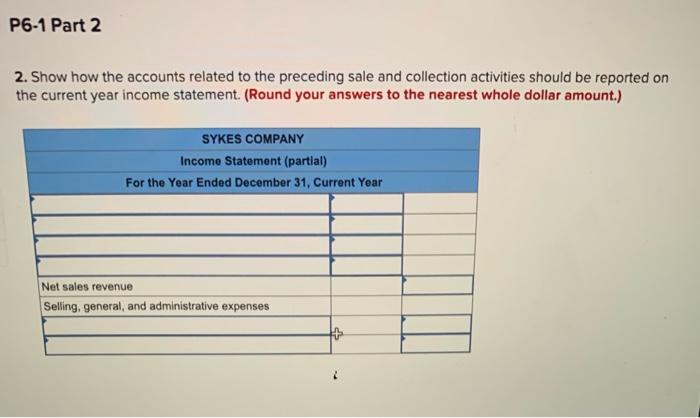Answered step by step
Verified Expert Solution
Question
1 Approved Answer
The following data were selected from the records of Sykes Company for the year ended December 31, current year. Balances January 1, current year




The following data were selected from the records of Sykes Company for the year ended December 31, current year. Balances January 1, current year Accounts receivable (various customers) Allowance for doubtful accounts. In the following order, except for cash sales, the company sold merchandise and made collections on credit terms 4/10, n/30 (assume a unit sales price of $700 in all transactions). Transactions during current year a. Sold merchandise for cash, $260,000. b. Sold merchandise to R. Smith; invoice price, $10,500. c. Sold merchandise to K. Miller; invoice price, $31,000. d. Two days after purchase date, R. Smith returned one of the units purchased in (b) and received account credit. $ 122,000 6,000 e. Sold merchandise to B. Sears; invoice price, $29,000. f. R. Smith paid his account in full within the discount period. g. Collected $99,000 cash from customer sales on credit in prior year, all within the discount periods. h. K. Miller paid the invoice in (c) within the discount period. i. Sold merchandise to R. Roy; invoice price, $25,500. j. Three days after paying the account in full, K. Miller returned seven defective units and received a cash refund. Aannthe di 1. alland 300-t d. Two days after purchase date, R. Smith returned one of the units purchased in (b) and received account credit. e. Sold merchandise to B. Sears; invoice price, $29,000. f. R. Smith paid his account in full within the discount period. g. Collected $99,000 cash from customer sales on credit in prior year, all within the discount periods. h. K. Miller paid the invoice in (c) within the discount period. i. Sold merchandise to R. Roy; invoice price, $25,500. j. Three days after paying the account in full, K. Miller returned seven defective units and received a cash refund. k. After the discount period, collected $4,000 cash on an account receivable on sales in a prior year. 1. Wrote off a prior year account of $2,000 after deciding that the amount would never be collected. m. The estimated bad debt rate used by the company was 1.0 percent of credit sales net of returns. P6-1 Part 1 Required: 1. Using the following categories, indicate the effect of each listed transaction, including the write-off of the uncollectible account and the adjusting entry for estimated bad debts (ignore cost of goods sold). The first transaction is used as an example. (Round your answers to the nearest whole dollar amount. Any decrease in account balances should be indicated by a minus sign.) Transaction a. b. C. d. e. f. g. h. i. j. k. 1. m. Total Sales Revenue $ 260,000 Sales Discounts (taken) $ 260,000 $ Sales Returns and Allowances 0 $ 6 $ Bad Debt Expense 0 P6-1 Part 2 2. Show how the accounts related to the preceding sale and collection activities should be reported on the current year income statement. (Round your answers to the nearest whole dollar amount.) SYKES COMPANY Income Statement (partial) For the Year Ended December 31, Current Year Net sales revenue Selling, general, and administrative expenses The following data were selected from the records of Sykes Company for the year ended December 31, current year. Balances January 1, current year Accounts receivable (various customers) Allowance for doubtful accounts. In the following order, except for cash sales, the company sold merchandise and made collections on credit terms 4/10, n/30 (assume a unit sales price of $700 in all transactions). Transactions during current year a. Sold merchandise for cash, $260,000. b. Sold merchandise to R. Smith; invoice price, $10,500. c. Sold merchandise to K. Miller; invoice price, $31,000. d. Two days after purchase date, R. Smith returned one of the units purchased in (b) and received account credit. $ 122,000 6,000 e. Sold merchandise to B. Sears; invoice price, $29,000. f. R. Smith paid his account in full within the discount period. g. Collected $99,000 cash from customer sales on credit in prior year, all within the discount periods. h. K. Miller paid the invoice in (c) within the discount period. i. Sold merchandise to R. Roy; invoice price, $25,500. j. Three days after paying the account in full, K. Miller returned seven defective units and received a cash refund. Aannthe di 1. alland 300-t d. Two days after purchase date, R. Smith returned one of the units purchased in (b) and received account credit. e. Sold merchandise to B. Sears; invoice price, $29,000. f. R. Smith paid his account in full within the discount period. g. Collected $99,000 cash from customer sales on credit in prior year, all within the discount periods. h. K. Miller paid the invoice in (c) within the discount period. i. Sold merchandise to R. Roy; invoice price, $25,500. j. Three days after paying the account in full, K. Miller returned seven defective units and received a cash refund. k. After the discount period, collected $4,000 cash on an account receivable on sales in a prior year. 1. Wrote off a prior year account of $2,000 after deciding that the amount would never be collected. m. The estimated bad debt rate used by the company was 1.0 percent of credit sales net of returns. P6-1 Part 1 Required: 1. Using the following categories, indicate the effect of each listed transaction, including the write-off of the uncollectible account and the adjusting entry for estimated bad debts (ignore cost of goods sold). The first transaction is used as an example. (Round your answers to the nearest whole dollar amount. Any decrease in account balances should be indicated by a minus sign.) Transaction a. b. C. d. e. f. g. h. i. j. k. 1. m. Total Sales Revenue $ 260,000 Sales Discounts (taken) $ 260,000 $ Sales Returns and Allowances 0 $ 6 $ Bad Debt Expense 0 P6-1 Part 2 2. Show how the accounts related to the preceding sale and collection activities should be reported on the current year income statement. (Round your answers to the nearest whole dollar amount.) SYKES COMPANY Income Statement (partial) For the Year Ended December 31, Current Year Net sales revenue Selling, general, and administrative expenses The following data were selected from the records of Sykes Company for the year ended December 31, current year. Balances January 1, current year Accounts receivable (various customers) Allowance for doubtful accounts. In the following order, except for cash sales, the company sold merchandise and made collections on credit terms 4/10, n/30 (assume a unit sales price of $700 in all transactions). Transactions during current year a. Sold merchandise for cash, $260,000. b. Sold merchandise to R. Smith; invoice price, $10,500. c. Sold merchandise to K. Miller; invoice price, $31,000. d. Two days after purchase date, R. Smith returned one of the units purchased in (b) and received account credit. $ 122,000 6,000 e. Sold merchandise to B. Sears; invoice price, $29,000. f. R. Smith paid his account in full within the discount period. g. Collected $99,000 cash from customer sales on credit in prior year, all within the discount periods. h. K. Miller paid the invoice in (c) within the discount period. i. Sold merchandise to R. Roy; invoice price, $25,500. j. Three days after paying the account in full, K. Miller returned seven defective units and received a cash refund. Aannthe di 1. alland 300-t d. Two days after purchase date, R. Smith returned one of the units purchased in (b) and received account credit. e. Sold merchandise to B. Sears; invoice price, $29,000. f. R. Smith paid his account in full within the discount period. g. Collected $99,000 cash from customer sales on credit in prior year, all within the discount periods. h. K. Miller paid the invoice in (c) within the discount period. i. Sold merchandise to R. Roy; invoice price, $25,500. j. Three days after paying the account in full, K. Miller returned seven defective units and received a cash refund. k. After the discount period, collected $4,000 cash on an account receivable on sales in a prior year. 1. Wrote off a prior year account of $2,000 after deciding that the amount would never be collected. m. The estimated bad debt rate used by the company was 1.0 percent of credit sales net of returns. P6-1 Part 1 Required: 1. Using the following categories, indicate the effect of each listed transaction, including the write-off of the uncollectible account and the adjusting entry for estimated bad debts (ignore cost of goods sold). The first transaction is used as an example. (Round your answers to the nearest whole dollar amount. Any decrease in account balances should be indicated by a minus sign.) Transaction a. b. C. d. e. f. g. h. i. j. k. 1. m. Total Sales Revenue $ 260,000 Sales Discounts (taken) $ 260,000 $ Sales Returns and Allowances 0 $ 6 $ Bad Debt Expense 0 P6-1 Part 2 2. Show how the accounts related to the preceding sale and collection activities should be reported on the current year income statement. (Round your answers to the nearest whole dollar amount.) SYKES COMPANY Income Statement (partial) For the Year Ended December 31, Current Year Net sales revenue Selling, general, and administrative expenses The following data were selected from the records of Sykes Company for the year ended December 31, current year. Balances January 1, current year Accounts receivable (various customers) Allowance for doubtful accounts. In the following order, except for cash sales, the company sold merchandise and made collections on credit terms 4/10, n/30 (assume a unit sales price of $700 in all transactions). Transactions during current year a. Sold merchandise for cash, $260,000. b. Sold merchandise to R. Smith; invoice price, $10,500. c. Sold merchandise to K. Miller; invoice price, $31,000. d. Two days after purchase date, R. Smith returned one of the units purchased in (b) and received account credit. $ 122,000 6,000 e. Sold merchandise to B. Sears; invoice price, $29,000. f. R. Smith paid his account in full within the discount period. g. Collected $99,000 cash from customer sales on credit in prior year, all within the discount periods. h. K. Miller paid the invoice in (c) within the discount period. i. Sold merchandise to R. Roy; invoice price, $25,500. j. Three days after paying the account in full, K. Miller returned seven defective units and received a cash refund. Aannthe di 1. alland 300-t d. Two days after purchase date, R. Smith returned one of the units purchased in (b) and received account credit. e. Sold merchandise to B. Sears; invoice price, $29,000. f. R. Smith paid his account in full within the discount period. g. Collected $99,000 cash from customer sales on credit in prior year, all within the discount periods. h. K. Miller paid the invoice in (c) within the discount period. i. Sold merchandise to R. Roy; invoice price, $25,500. j. Three days after paying the account in full, K. Miller returned seven defective units and received a cash refund. k. After the discount period, collected $4,000 cash on an account receivable on sales in a prior year. 1. Wrote off a prior year account of $2,000 after deciding that the amount would never be collected. m. The estimated bad debt rate used by the company was 1.0 percent of credit sales net of returns. P6-1 Part 1 Required: 1. Using the following categories, indicate the effect of each listed transaction, including the write-off of the uncollectible account and the adjusting entry for estimated bad debts (ignore cost of goods sold). The first transaction is used as an example. (Round your answers to the nearest whole dollar amount. Any decrease in account balances should be indicated by a minus sign.) Transaction a. b. C. d. e. f. g. h. i. j. k. 1. m. Total Sales Revenue $ 260,000 Sales Discounts (taken) $ 260,000 $ Sales Returns and Allowances 0 $ 6 $ Bad Debt Expense 0 P6-1 Part 2 2. Show how the accounts related to the preceding sale and collection activities should be reported on the current year income statement. (Round your answers to the nearest whole dollar amount.) SYKES COMPANY Income Statement (partial) For the Year Ended December 31, Current Year Net sales revenue Selling, general, and administrative expenses The following data were selected from the records of Sykes Company for the year ended December 31, current year. Balances January 1, current year Accounts receivable (various customers) Allowance for doubtful accounts. In the following order, except for cash sales, the company sold merchandise and made collections on credit terms 4/10, n/30 (assume a unit sales price of $700 in all transactions). Transactions during current year a. Sold merchandise for cash, $260,000. b. Sold merchandise to R. Smith; invoice price, $10,500. c. Sold merchandise to K. Miller; invoice price, $31,000. d. Two days after purchase date, R. Smith returned one of the units purchased in (b) and received account credit. $ 122,000 6,000 e. Sold merchandise to B. Sears; invoice price, $29,000. f. R. Smith paid his account in full within the discount period. g. Collected $99,000 cash from customer sales on credit in prior year, all within the discount periods. h. K. Miller paid the invoice in (c) within the discount period. i. Sold merchandise to R. Roy; invoice price, $25,500. j. Three days after paying the account in full, K. Miller returned seven defective units and received a cash refund. Aannthe di 1. alland 300-t d. Two days after purchase date, R. Smith returned one of the units purchased in (b) and received account credit. e. Sold merchandise to B. Sears; invoice price, $29,000. f. R. Smith paid his account in full within the discount period. g. Collected $99,000 cash from customer sales on credit in prior year, all within the discount periods. h. K. Miller paid the invoice in (c) within the discount period. i. Sold merchandise to R. Roy; invoice price, $25,500. j. Three days after paying the account in full, K. Miller returned seven defective units and received a cash refund. k. After the discount period, collected $4,000 cash on an account receivable on sales in a prior year. 1. Wrote off a prior year account of $2,000 after deciding that the amount would never be collected. m. The estimated bad debt rate used by the company was 1.0 percent of credit sales net of returns. P6-1 Part 1 Required: 1. Using the following categories, indicate the effect of each listed transaction, including the write-off of the uncollectible account and the adjusting entry for estimated bad debts (ignore cost of goods sold). The first transaction is used as an example. (Round your answers to the nearest whole dollar amount. Any decrease in account balances should be indicated by a minus sign.) Transaction a. b. C. d. e. f. g. h. i. j. k. 1. m. Total Sales Revenue $ 260,000 Sales Discounts (taken) $ 260,000 $ Sales Returns and Allowances 0 $ 6 $ Bad Debt Expense 0 P6-1 Part 2 2. Show how the accounts related to the preceding sale and collection activities should be reported on the current year income statement. (Round your answers to the nearest whole dollar amount.) SYKES COMPANY Income Statement (partial) For the Year Ended December 31, Current Year Net sales revenue Selling, general, and administrative expenses
Step by Step Solution
★★★★★
3.41 Rating (154 Votes )
There are 3 Steps involved in it
Step: 1
Answer 1 Transaction Sales Revenue Sales Discounts taken Sales Returns and Allowances B...
Get Instant Access to Expert-Tailored Solutions
See step-by-step solutions with expert insights and AI powered tools for academic success
Step: 2

Step: 3

Ace Your Homework with AI
Get the answers you need in no time with our AI-driven, step-by-step assistance
Get Started


